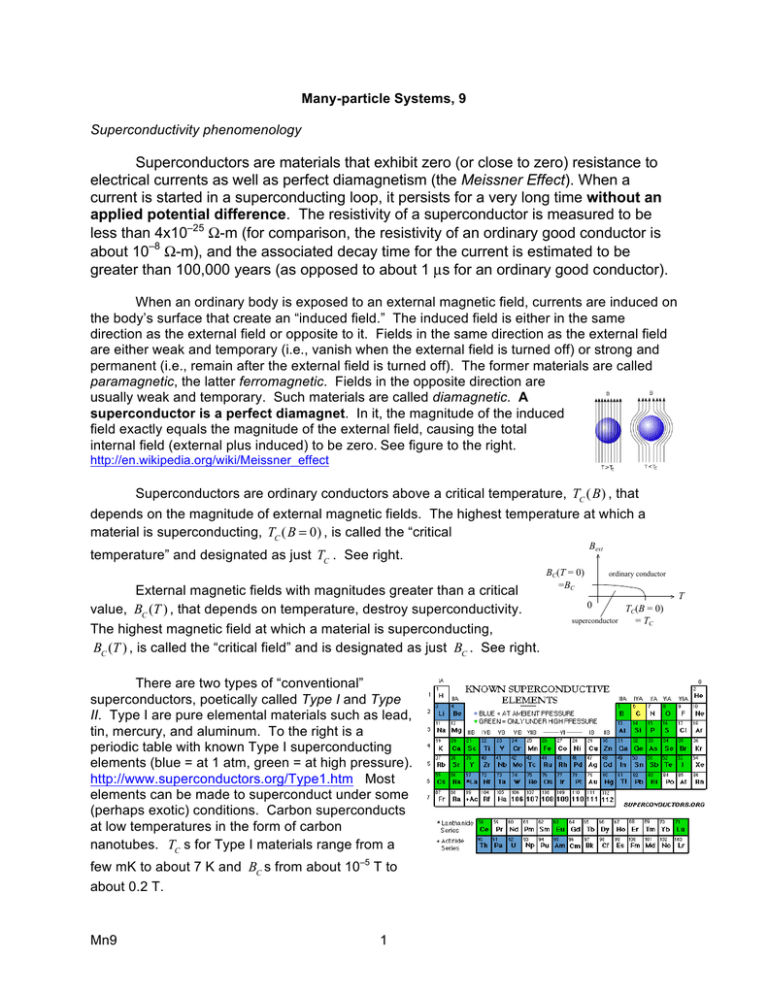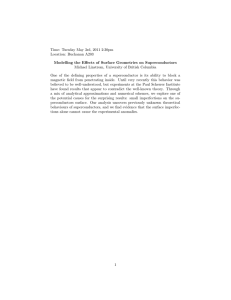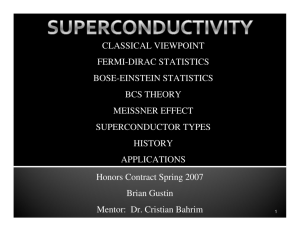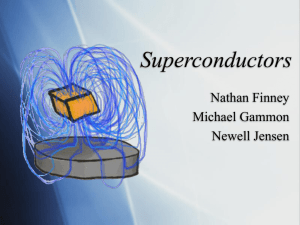Superconductors are materials that exhibit zero (or close to zero
advertisement

Many-particle Systems, 9 Superconductivity phenomenology Superconductors are materials that exhibit zero (or close to zero) resistance to electrical currents as well as perfect diamagnetism (the Meissner Effect). When a current is started in a superconducting loop, it persists for a very long time without an applied potential difference. The resistivity of a superconductor is measured to be less than 4x10–25 Ω-m (for comparison, the resistivity of an ordinary good conductor is about 10–8 Ω-m), and the associated decay time for the current is estimated to be greater than 100,000 years (as opposed to about 1 µs for an ordinary good conductor). When an ordinary body is exposed to an external magnetic field, currents are induced on the body’s surface that create an “induced field.” The induced field is either in the same direction as the external field or opposite to it. Fields in the same direction as the external field are either weak and temporary (i.e., vanish when the external field is turned off) or strong and permanent (i.e., remain after the external field is turned off). The former materials are called paramagnetic, the latter ferromagnetic. Fields in the opposite direction are usually weak and temporary. Such materials are called diamagnetic. A superconductor is a perfect diamagnet. In it, the magnitude of the induced field exactly equals the magnitude of the external field, causing the total internal field (external plus induced) to be zero. See figure to the right. http://en.wikipedia.org/wiki/Meissner_effect Superconductors are ordinary conductors above a critical temperature, TC (B) , that depends on the magnitude of external magnetic fields. The highest temperature at which a material is superconducting, TC (B = 0) , is called the “critical Bext temperature” and designated as just TC . See right. External magnetic fields with magnitudes greater than a critical value, BC (T ) , that depends on temperature, destroy superconductivity. The highest magnetic field at which a material is superconducting, BC (T ) , is called the “critical field” and is designated as just BC . See right. There are two types of “conventional” superconductors, poetically called Type I and Type II. Type I are pure elemental materials such as lead, tin, mercury, and aluminum. To the right is a periodic table with known Type I superconducting elements (blue = at 1 atm, green = at high pressure). http://www.superconductors.org/Type1.htm Most elements can be made to superconduct under some (perhaps exotic) conditions. Carbon superconducts at low temperatures in the form of carbon nanotubes. TC s for Type I materials range from a few mK to about 7 K and BC s from about 10–5 T to about 0.2 T. Mn9 1 BC(T = 0) =BC ordinary conductor 0 superconductor T TC(B = 0) = TC Type II superconductors are compounds or alloys such as V3In, NbN, MgB2, and YSr2Cu3O7. TC s for Type I materials range from about 10K to about 30 K and BC s from about 1 T to about 50 T. The whole interior of a Type I superconductor is superconducting. The interior of a Type II superconductor, on the other hand, is an interweaving of superconducting and ordinary conducting materials. When a magnet is brought close to a Type II superconductor, the external field organizes the materials into strands of ordinary conducting material running through the volume surrounded by superconducting material, as depicted to the right. The external magnetic field is excluded from the superconducting portion, but penetrates through the ordinary strands. For this reason, the strands are called “flux tubes.” Type II materials exhibit two critical fields. Below BC1 (T ) the material Bext is pure Type I. Above BC 2 (T ) , the material is an ordinary conductor. Type II BC2 behavior exists for fields between BC1 (T ) and BC 2 (T ) . As the field is increased in the Type II region the density of ordinary strands increases until they completely fill the interior (at field strength BC 2 (T ) ). BC1 ordinary conductor Type II 0 T Type I TC There are also “unconventional” superconductors, called “high TC ” superconductors. These materials have unlovely (ceramic) chemical composition, for example, Hg0.8Tl0.2Ba2Ca2Cu3O8.33. This particular combination of stuff (synthesized at 1 atm) has the highest confirmed TC: 138 K (61 K above liquid nitrogen). Recently, various other compounds have been synthesized that show sharp, but small, dips in resistivity and corresponding magnetic effects at well-defined temperatures. The record for this dipping is about 310 K, observed in January 2013: http://www.superconductors.org/38c_rec.htm. Because the effect is small, however, superconductivity is only suggested in these materials. Isolating what the possible superconducting component might be awaits further investigation. Some hoped for and real applications That superconductors carry current without generating heat is potentially attractive for electrical power transmission purposes. The energy loss due to resistive heating in power lines in the US is about 6-7%. Replacing copper wires with superconducting wires would have a large economic impact. Of course, copper is not going to be replaced by wires that have to be kept at liquid nitrogen temperatures. So this application will have to await new, higher TC (room temperature?) materials (that aren’t brittle, like most high TC ceramics). Faster computers with smaller circuit elements are limited by heat generation, also. Again, for widespread commercial use, higher TC s are required. Magnetically levitated (maglev) trains take advantage of the Meissner Effect and “flux pinning.” In the figure to the right a strong, rare earth magnet is repelled by the magnetic field induced in the superconducting pellet (required to keep the magnetic field inside the superconductor equal to zero) below it. The repulsion balances the weight of the magnet. But something else happens: if the magnet is pushed to one side and let go, it returns to where it started. If the superconducting pellet were Type I this wouldn’t occur. The Meissner Effect would cause repulsion sideways and the Mn9 2 permanent magnet would be pushed aside. The superconducting pellet is Type II and is permeated by narrow flux tubes in which the magnetic field strengths are large. Moving the permanent magnet around attempts to change the flux in the tubes which is resisted by strong induced currents. The net result is a kind of attractive magnetic force in addition the repulsive force due to Meissner. In train applications, the train carries the superconducting material and the tracks carry current and magnetic field. Several experimental maglev lines exist around the world; the only commercial line to date is in China, running between the Pudong airport and the outskirts of Shanghai (30 km). At the midpoint of the ride, the train travels at 430 km/h (270 mph) and the total trip takes 7 minutes. The cost of this line was about $1B, too expensive at present for a large expansion of maglev lines worldwide. Magnetic Resonance Imaging (MRI) is the one current application with huge economic impact. There are over 20,000 units in service in the world (cost: $100B), all generating large revenue through imaging fees. MRI machines use superconducting wire coils and operate with field strengths of 1-3 T. Research magnets have fields as high as 60 T. High field superconducting magnets are also used in high-energy accelerators such the Tevatron at Fermilab or the Large Hadron Collider at CERN to steer the (very fast) beam around the accelerator ring. Some theoretical ideas A perfect conductor rapidly rearranges surface charges so that there is no total electric field within the material. Similarly, a perfect diamagnet rapidly rearranges surface currents so that there is no total magnetic field within the material. In principle, a material might be a perfect conductor without being a perfect diamagnet (and vice versa). Only superconductors are both. Applying Ampere’s Law, ∫ B idl = µ I , to closed loops within a superconductor shows 0 that there can be no current inside (since the magnetic field is zero). Therefore, all of the current a superconductor carries resides “on” its surface. In fact, the superconducting current is actually spread through a thickness, λ L , the “London penetration depth,” inward from the surface. Throughout the penetration region the magnetic field is not zero, being strongest at the surface and rapidly weakening inward. The penetration depth is typically on the order of 100 nm. For Type I and Type II superconductors, the critical temperature for a given material varies with the average atomic mass of the lattice atoms like M −1/2 . Lighter isotopes (nuclei with the same number of protons but different numbers of neutrons) have slightly higher TC s. In addition, the very good electrical conductors, Cu, Ag, and Au, do not have superconducting states. Both of these facts suggest that the interaction of electrons with phonons is essential for conventional superconductivity. In conventional superconductors, two electrons with equal and oppositely directed momenta and opposite spin directions effectively attract one another by exchanging phonons. Roughly, the picture is: the negative charge of one electron draws nearby positively charged lattice atoms toward it and the attractive interactions slow the electron a bit; the slight (positively charged) distortion of the lattice propagates away from the first electron until it encounters a second electron with the correct momentum and spin and produces a little tug on it, slowing it down as well. The net effect is that the two electrons slow a little by this lattice distortion Mn9 3 exchange (phonon); it’s as if they attract. If thermally excited phonons are too energetic then the induced effective attraction will be dominated by the random buffeting of the phonons. The effective attraction is only significant below a critical (low) temperature. The two electrons form a composite system with zero spin: they become a (tenuously bound) boson. At low temperatures in superconductors there are many electron-pair-bosons. They condense into a huge wavefunction with highly correlated electron motions—producing an electron superfluid. The electron pairs responsible for superconductivity are called Cooper pairs, after Leon Cooper who first proposed them (1956). The very complicated formal theory of Type I and Type II superconductivity based on Cooper pairs is called the BCS theory (for John Bardeen, Cooper, and John Schrieffer). Example: The attractive energy between electrons in a Cooper pair is only about 10–3 eV. So T has to be less than about 30 K for superconductivity to exist by this mechanism. In addition, if the electrons in the pair are closer than about 1 mm (10,000 atoms) their repulsion will overcome the phonon-assisted attraction and blow the pair apart. Pretty weird pairs. High TC superconductivity does not follow this “conventional” scenario. Though Cooper pairs are still suspected to exist, their effective attraction is probably not due solely to phonons. Cooper pairs in ordinary superconductors have their spins anti-aligned; the pairs have total spin = 0. In high TC superconductivity the Cooper pair partners have spin aligned; there, they have nonzero integer spin. High TC superconductors have lots of different kinds of atoms arranged in stacked planes. Superconductivity only occurs along the plane directions, so the planar geometry must be important. To date, 30 years after their discovery, there is still no universally accepted theory of high TC superconductivity (despite continuing intense efforts to produce one). Mn9 4






